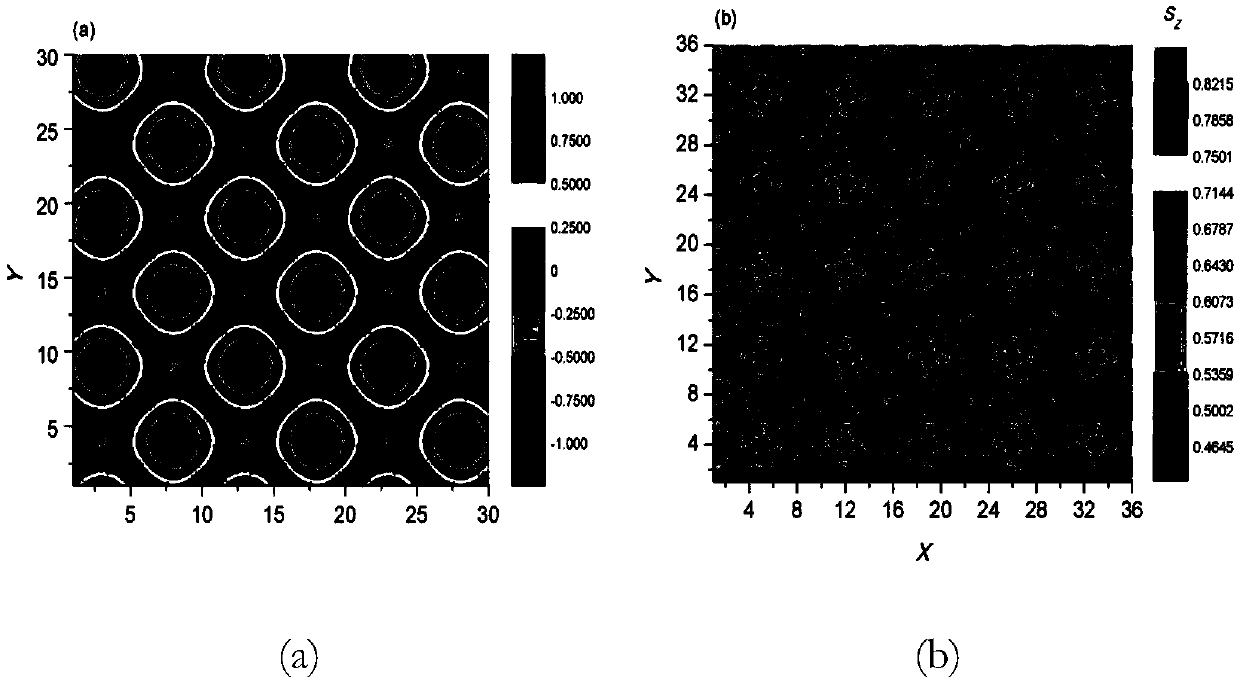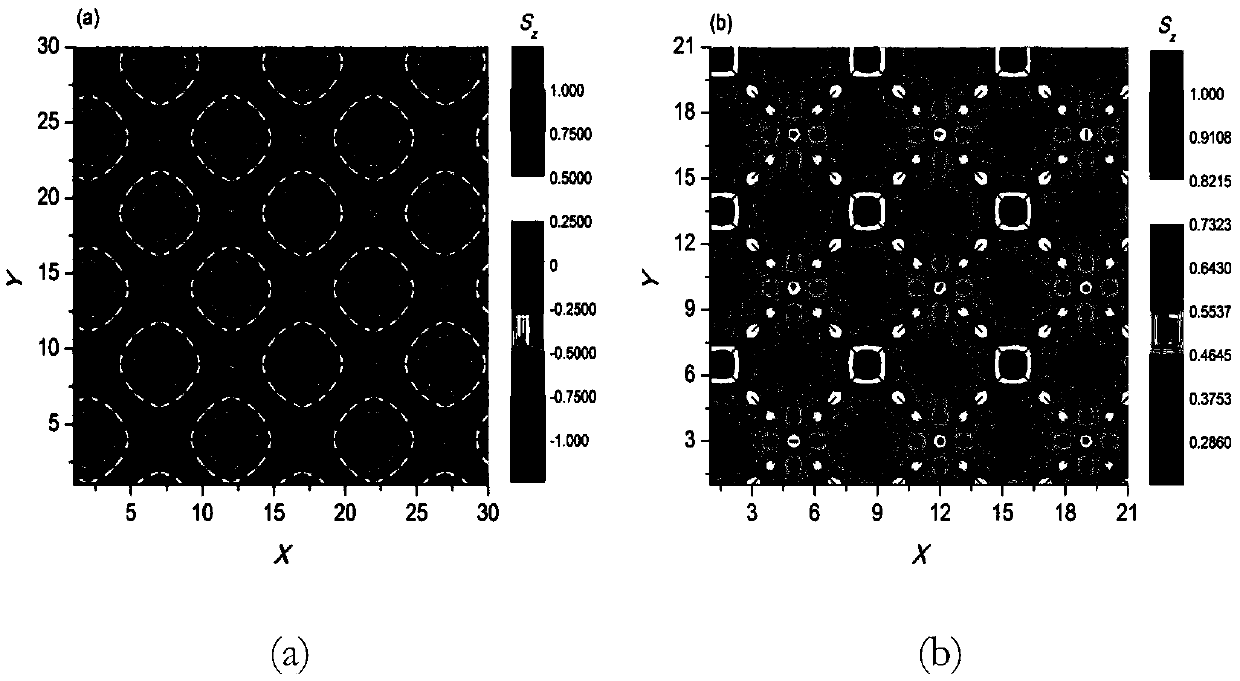Quantum mechanics simulation method for magnetic skyrmion lattices and magnetic vortex lattices
A technology of skyrmion lattice and quantum mechanics, which is applied in the field of quantum mechanical simulation of magnetic skyrmion lattice and magnetic vortex lattice, can solve the problem of inability to simulate antiferromagnetic skyrmion lattice, Monte-Carlo Lo is not ideal, the micromagnetic description is no longer accurate and reliable, etc.
- Summary
- Abstract
- Description
- Claims
- Application Information
AI Technical Summary
Problems solved by technology
Method used
Image
Examples
Embodiment 1
[0092] Embodiment 1: Ferromagnetic Skymion Crystal of Bloch-Type Ferromagnetic Skymion Crystal of Bloch-Type
[0093] A 30×30 square grid is used in the simulation, and there is a spin of S=1 on each grid point. In order to simulate infinite two-dimensional systems with it, periodic boundary conditions are adopted. The effect of perpendicular anisotropy is not considered here, and J=1K is set, and D / J=1.02733, so that the periodic distance between skyrmions λ=10.
[0094] It can be seen from the simulation results that in the absence of an external field, the spontaneous ground state of this two-dimensional system is a strip structure along the [110] direction; gradually increasing the vertical external magnetic field When 0.11Tesla≤B≤0.27Tesla, a skyrmion lattice with a regular hexagonal close-packed structure will be produced in a square lattice; in a weak magnetic field, the space period of this array is 10, which is consistent with the theory; In the magnetic fie...
Embodiment 2
[0097] Embodiment 2: Bloch-type antiferromagnetic skyrmion array (Antiferromagnetic Skymion Crystalof Bloch-Type)
[0098] For this example, we study the antiferromagnetic situation, so take J=-1K, D=1K (so D / J=-1), K A = 0[8]. A 56×56 square grid is adopted, and there is a 5=1 spin on each grid point. Use periodic boundary conditions to simulate infinite two-dimensional systems. In the simulation, it was found that when the vertical applied magnetic field intensity satisfies 3.9Tesla≤B≤4.1Tesla, the antiferromagnetic skyrmion array can be formed in the temperature range of T / J<1.6; slightly increasing or weakening the applied magnetic field, antiferromagnetic The magnetic skyrmion lattice disappears and is replaced by an antiferromagnetic structure.
[0099] Figure II (b) shows the simulated antiferromagnetic skyrmion lattice at B=4Tesla, T / J=0.1. It has perfect symmetry with a space period λ=7. The average value of the z component of the spin in each skyrmion c...
example 1
[0100] B in Example 1 1 =0.11Tesla, B in Example 2 2 =4Tesla, and the ratio of D / J of the two is similar, but B2 / B1≈36.4. Therefore, to observe an array of antiferromagnetic skyrmions, a 36 times stronger magnetic field needs to be applied. In addition, the antiferromagnetic skyrmion lattice only exists in a narrow B interval, so it lacks good stability. All of these make experimental observations much more difficult.
[0101] It is necessary to point out that in order to simulate the antiferromagnetic skyrmions on the square lattice, R. Keesman et al. set J=-1, D / |J|=1, H / |J|=4, only in the 8×8 A single skyrmion can be simulated on a square lattice of finite size, but an antiferromagnetic skyrmion lattice on an infinite square system cannot be simulated [8]. However, the theoretical research by Tretiakov et al. showed that such skyrmions exist at non-zero temperatures and are more stable in an external magnetic field[23]. Therefore, this example illustrates the sig...
PUM
 Login to View More
Login to View More Abstract
Description
Claims
Application Information
 Login to View More
Login to View More - R&D
- Intellectual Property
- Life Sciences
- Materials
- Tech Scout
- Unparalleled Data Quality
- Higher Quality Content
- 60% Fewer Hallucinations
Browse by: Latest US Patents, China's latest patents, Technical Efficacy Thesaurus, Application Domain, Technology Topic, Popular Technical Reports.
© 2025 PatSnap. All rights reserved.Legal|Privacy policy|Modern Slavery Act Transparency Statement|Sitemap|About US| Contact US: help@patsnap.com



